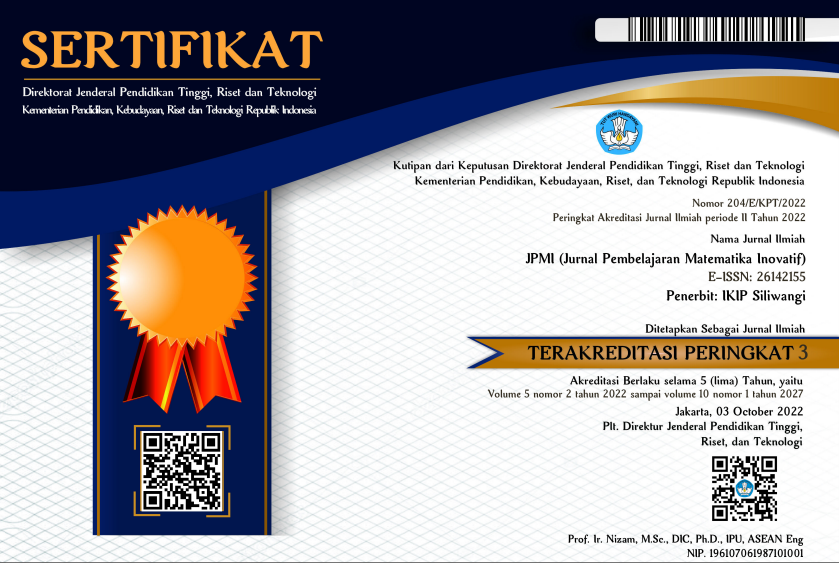AKTIVITAS DAN PEMECAHAN MASALAH MATEMATIKA MENGGUNAKAN MODEL PROBLEM BASED LEARNING DI SMK
DOI:
https://doi.org/10.22460/jpmi.v4i1.6430Kata Kunci:
Activites, Problem Solving, Problem Based LearningAbstrak
Referensi
Adiastuty, N., Rochmad, & Masrukan. (2012). Perangkat Pembelajaran Model BBL Materi Barisan dan Deret untuk Meningkatkan Kemampuan Pemecahan Masalah. Unnes Journal of Mathematics Education, 1(2), 87–93.
Akinoǧlu, O., & Tandoǧan, R. Ö. (2007). The Effects of Problem-Based Active Learning in Science Education on Students’ Academic Achievement, Attitude and Concept Learning. Eurasia Journal of Mathematics, Science and Technology Education, 3(1), 71–81. https://doi.org/10.12973/ejmste/75375
Fadly, A. (2012). Peningkatan Aktivitas dan Hasil Belajar Siswa Melalui Model Pembelajaran Problem Based Learning (PBL) (Studi pada Kelas X Bisnis dan Manajemen Mata Pelajaran Kewirausahaan di SMK Ardjuna 1 Malang). Jurnal Fakultas Ekonomi Universitas Negeri Malang, 1–15.
Husnidar, Ikhsan, M., & Rizal, S. (2014). Penerapan Model Pembelajaran Berbasis Masalah untuk Meningkatkan Kemampuan Berpikir Kritis dan Disposisi Matematis Siswa. Jurnal Didaktik Matematika, 1(1), 71–82. https://doi.org/10.24815/jdm.v1i1.1243
Ifanali. (2014). Penerapan Langkah-langkah Polya untuk Meningkatkan Pemecahan Masalah Soal Cerita Pecahan Pada Siswa Kelas VII SMA Negeri 13 Palu. Jurnal Elektronik Pendidikan Matematika Tadulako, 1(2), 147–158. http://jurnal.untad.ac.id/jurnal/index.php/JEPMT/article/view/3217
Jaisook, S., Chidmongkol, S., & Thongthew, S. (2013). A Mathematics Instructional Model by Integrating Problem Based Learning and Collaborative Learning Approaches. 7th International Technology, Education and Development Conference, 13(2), 271–294.
Lestanti, M. L. (2015). Analisis Kemampuan Pemecahan Masalah Ditinjau Dari Karakteristik Cara Berpikir Siswa Dalam Model Problem Based Learning. Doctoral dissertation, Universitas Negeri Semarang
Masrurotullaily, Hobri, & Suharto. (2013). Analisis Kemampuan Pemecahan Masalah Matematika Keuangan Berdasarkan Model Polya Siswa Smk Negeri 6 Jember. Kadikma, 4(2), 129–138.
Mawaddah, S., & Anisah, H. (2015). Kemampuan Pemecahan Masalah Matematis Siswa Pada Pembelajaran Matematika dengan Menggunakag Model Pembelajaran Generatif (Generative Learning) di SMP. EDU-MAT: Jurnal Pendidikan Matematika, 3(2), 166–175. https://doi.org/10.20527/edumat.v3i2.644
Miranti, N. K., Agoestanto, A., & Kurniasih, A. W. (2015). Komparasi Pembelajaran Mea Dan PBL Terhadap Kemampuan Pemecahan Masalah Dan Disposisi Matematis Siswa SMP Kelas VIII Pada Materi SPLDV. Unnes Journal of Mathematics Education, 4(3), 213–221. http://journal.unnes.ac.id/sju/index.php/ijcs
Muntaha, A., & Hartono. (2013). Pengembangan Perangkat Pembelajaran Model Problem Based Learning Untuk Meningkatkan Kemampuan Berfikir Kreatif. Journal of Primary Educational, 2(2), 115–119.
Rerung, N., Sinon, I. L. S., & Widyaningsih, S. W. (2017). Penerapan Model Pembelajaran Problem Based Learning (PBL) Untuk Meningkatkan Hasil Belajar Peserta Didik SMA Pada Materi Usaha dan Energi. Jurnal Ilmiah Pendidikan Fisika Al-BiRuNi, 6(1), 47–55. https://doi.org/10.33578/jpfkip.v7i1.5338
Sari, S. (2014). Pengaruh Pendekatan Pembelajaran Berbasis Masalah Terhadap Kemampuan Pemecahan Masalah Matematika Siswa Kelas VIII SMP Negeri 1 Padang Tahun Pelajaran 2013/2014. Doctoral dissertation, Universitas Negeri Padang.
Yanti, A. P., & Syazali, M. (2016). Analisis Proses Berpikir Siswa dalam Memecahkan Masalah Matematika Berdasarkan Langkah-Langkah Bransford dan Stein Ditinjau dari Adversity Quotient. Al-Jabar: Jurnal Pendidikan Matematika, 7(1), 63–74.
Unduhan
File Tambahan
Diterbitkan
Terbitan
Bagian
Lisensi
Hak Cipta (c) 2021 JPMI (Jurnal Pembelajaran Matematika Inovatif)

Artikel ini berlisensiCreative Commons Attribution-ShareAlike 4.0 International License.
The author is responsible for acquiring the permission(s) to reproduce any copyrighted figures, tables, data, or text that are being used in the submitted paper. Authors should note that text quotations of more than 250 words from a published or copyrighted work will require grant of permission from the original publisher to reprint. The written permission letter(s) must be submitted together with the manuscript.
















